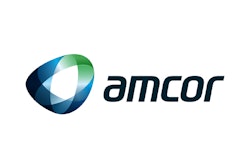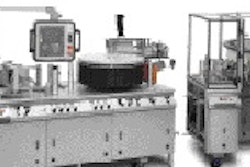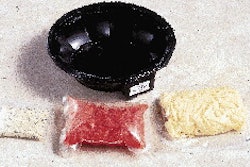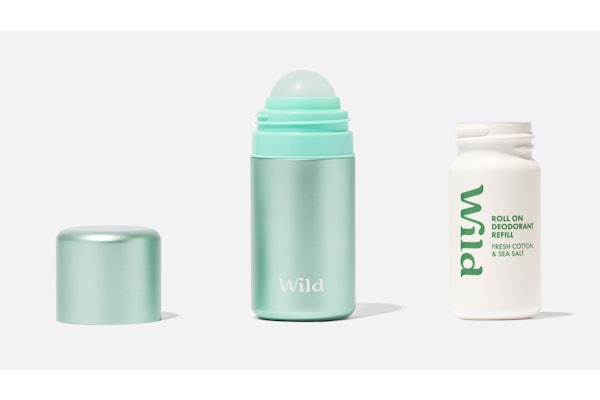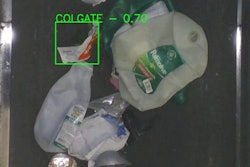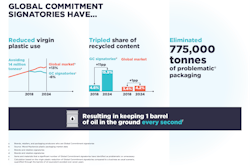There isn't enough space in this column to detail all the emerging technologies with the potential to help you accomplish these tasks. The editorial and advertising pages of this issue are full of new, practical and proven packaging ideas. A careful reading will certainly give you a sense of packaging's diversity and the infinite inventiveness of packagers and the vendors who serve them. In our recent travels, however, we've come across four new ideas (new to us, anyway) that could give your company--or your competition--an edge in the marketplace. Here, pretty much in the order we discovered them, are the concepts. If you'd like to explore these ideas further, e-mail me at the address below for contact information. PETCUP retortable aluminum cups: Developed and marketed by Lawson Mardon Picopac (Zutphen, the Netherlands), PETCUP is a family of retortable aluminum foil cups (see photo). They are aimed at the upscale cat and dog food market, though the convenience, attractiveness and retortability of the concept suggest they could be used effectively for a variety of human foods, as well (nuts, spreads, p't/, dips, to name just a few). Peel-open aluminum foil trays are already a two billion-unit-a-year business in Europe. And Picopac is positioning the 50-, 85-, 100- and 150-g PETCUPS between trays and steel cans (eight billion or so dominate the U.S. wet pet food market). "They require only twenty percent of the energy needed to open a ring-pull can end," Picopac officials tell us. Cups are designed to be displayed upside-down. Heat-sealed lids (in this case the bottoms of the containers) are made of 60-micron foil with a 25-micron polypropylene extrusion coating. Lids (bottoms) are recessed 1.5 mm to permit multiple-tier stacking of the containers. Isostatic pressure pasteurization: Most consumers think fresh foods taste better and are more nutritious than heat-pasteurized varieties. In the quest to offer processed foods with the taste and nutrition equivalency of fresh, processors of various liquid-content foods are turning to a technique that pasteurizes food by subjecting it to ultra-high (50ꯠ-100ꯠ psi) pressures from all directions. Right now, the only known commercial application of isostatic pressure pasteurization is a batch system from the Engineered Systems Division of ABB Autoclave Systems, Inc. (Erie, PA). That system is being used by Avomex, Inc. (Keller, TX) for pouched avocado pulp and guacamole in air-evacuated pouches (see Packaging World, November '96, p. 9). A faster, semi-continuous flow "Fresher Under Pressure(TM)" system developed for pumpable foods by Flow Intl., Inc. (Kent, WA) is now being beta-tested by Avomex, Minute Maid Co. (Houston, TX) and Grupo Jumex (Xalostoc, Mexico). Because pressurization takes place while products are being pumped through a series of piston-like pressure chambers, foods can be packed in a wide range of conventional containers. Juices, sauces, baby food, purees, diced and chopped fruits and vegetables are among the first products on the Fresher Under Pressure menu. Portable productivity software: This is potentially the most broadly applicable of the four technologies touched on here. Imagine having the ability to automatically monitor the operational performance of every single piece of packaging equipment on your packaging line with specially developed software and some computer peripherals (cables, cycle sensors and lithium battery-powered data loggers) that you can carry from machine to machine in a briefcase. That, in a nutshell, is what Factory Pulse(TM) cycle and downtime technology from Factoryware, Inc. (Evanston, IL) promises. Downloaded onto a PC, the portable productivity pacer charts minute-by-minute yield analysis of the equipment being monitored. Histograms offer managers numerical readouts on peak productivity periods, output loss due to tooling wear and Cycle Erosion(TM), a measurement of the loss of output traceable to variations in cycle time. Fitments integrated into form/fill/seal systems for stylized pouches: Pouching technology continues to evolve. First there were pre-made pouches, then came form/fill/seal systems, followed by systems to apply fitments to pouches. Next were generations of pre-formed and f/f/s stand-up pouches. Now comes an integrated pouching system that forms stylized contour pouches, attaches dispensing fitments to them, fills the pouches through the fitments, then seals them. Developed by Laudenberg Verpackungsmaschinen GmbH (Wipperfrth, Germany), the system is debuting at BDF Beiersdorf AG (Hamburg, Germany), where it is producing 12-mL DispensPac(TM) pouches of Nivea for Men moisturizing shaving emulsion. The round-bottom pouches are designed as cartridges to fit into the Philishave CoolSkin wet & dry shaver from Philips Electronics NV, Amsterdam, the Netherlands. With line speeds of up to 160 pouches/min, the potential for this integrated stylized pouching system will, no doubt, go far beyond shaving cream cartridges. In the U.S., the Laudenberg line is represented by Profile Packaging, Inc. (Sarasota, FL).





